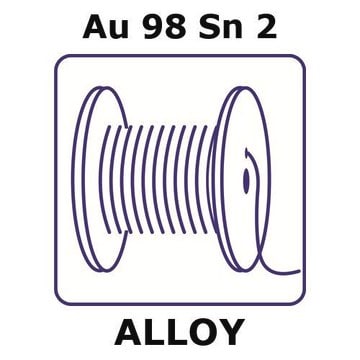GF62911313
Tin
wire reel, 1m, diameter 0.5mm, as drawn, 99.99+%
Sinônimo(s):
Tin, SN005120
Faça loginpara ver os preços organizacionais e de contrato
About This Item
Fórmula empírica (Notação de Hill):
Sn
Número CAS:
Peso molecular:
118.71
Número MDL:
Código UNSPSC:
12141745
ID de substância PubChem:
NACRES:
NA.23
Produtos recomendados
Ensaio
99.99%
forma
wire
fabricante/nome comercial
Goodfellow 629-113-13
resistividade
11 μΩ-cm, 20°C
C × diâmetro
1 m × 0.5 mm
pb
2270 °C (lit.)
pf
231.9 °C (lit.)
densidade
7.310 g/mL at 25 °C (lit.)
cadeia de caracteres SMILES
[Sn]
InChI
1S/Sn
chave InChI
ATJFFYVFTNAWJD-UHFFFAOYSA-N
Descrição geral
For updated SDS information please visit www.goodfellow.com.
Informações legais
Product of Goodfellow
Certificados de análise (COA)
Busque Certificados de análise (COA) digitando o Número do Lote do produto. Os números de lote e remessa podem ser encontrados no rótulo de um produto após a palavra “Lot” ou “Batch”.
Já possui este produto?
Encontre a documentação dos produtos que você adquiriu recentemente na biblioteca de documentos.
Gabriel Santpere et al.
Genome biology and evolution, 7(6), 1490-1505 (2015-05-16)
We set out to investigate potential differences and similarities between the selective forces acting upon the coding and noncoding regions of five different sets of genes defined according to functional and evolutionary criteria: 1) two reference gene sets presenting accelerated
Are nickel, vanadium, silicon, fluorine, and tin essential for man? A review.
F H Nielsen et al.
The American journal of clinical nutrition, 27(5), 515-520 (1974-05-01)
S G Schäfer et al.
Regulatory toxicology and pharmacology : RTP, 4(1), 57-69 (1984-03-01)
A tolerable limit for tin concentration in canned food of 250 ppm (Fritsch et al., 1977) is generally accepted. However, biochemical effects attributable to tin have been observed even after oral administration of 1 and 3 mg Sn/kg body wt
Mutagens and potential mutagens in the biosphere. II. Metals--mercury, lead, cadmium and tin.
L Fishbein
The Science of the total environment, 2(4), 341-371 (1974-07-01)
M R Krigman et al.
Neurotoxicology, 5(2), 129-139 (1984-01-01)
The toxicology of tin is almost entirely the toxicology of the organic compounds of tin, for the metal itself and its inorganic compounds appear to be nearly harmless for practical purposes. Furthermore, the neurotoxicity of organotin is essentially that of
Nossa equipe de cientistas tem experiência em todas as áreas de pesquisa, incluindo Life Sciences, ciência de materiais, síntese química, cromatografia, química analítica e muitas outras.
Entre em contato com a assistência técnica






